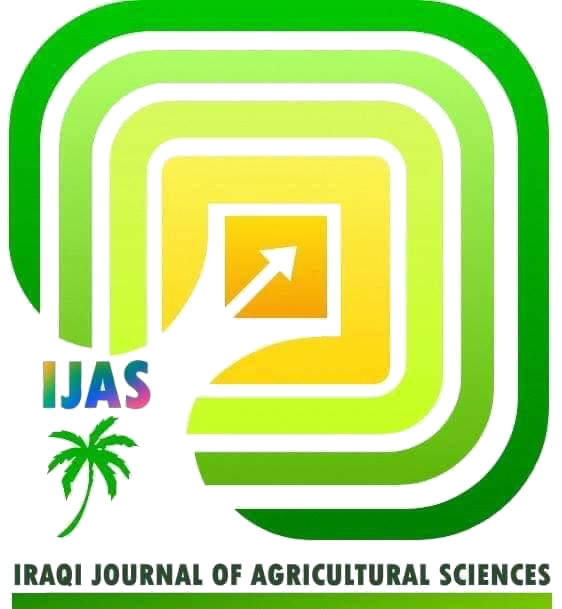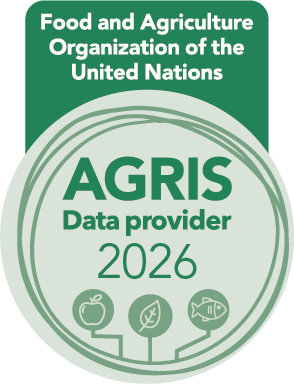LAND SUITABILITY ASSESSMENT USING AHP (ANALYTICAL HIERARCHY PROCESS) AND SYS,1993 METHODS IN ARID AND SEMI-ARID REGIONS FOR RICE FARMING
DOI:
https://doi.org/10.36103/63v0m103Keywords:
land evolution; soil salinity; rice; soil productivity.Abstract
This study was aimed to investigate the extent the land to productive due to the fact that climatic changes and the increase in population growth are reasons that led to an increase in the demand for food, especially in developing countries. Therefore, a scientific way must assess the suitability of lands for growing crops. This research aims to provide an integrated approach to the process of analyzing the suitability of agricultural lands for crop growth. Rice in the Al-Mishkhab region of Al-Najaf Governorate using the analytical hierarchy model AHP and compared with the method of (Sys, 1993) and the actual production in the field, 12 soil parameters were determined (electrical conductivity, soil interaction, cation exchange capacity, exchangeable sodium ratio, texture soil, lime, gypsum, organic carbon, drainage, soil depth, slope, flooding) and three criteria were added in the AHP method due to their importance in Iraqi soils, which are (total nitrogen, available phosphorus, crop class). The results were extracted and showed that all the results of the study Using the method (Sys, 1993) within the unsuitable range for cultivation N2, either using the analytical hierarchy method and giving varying importance to the above soil criteria, it was found that 12% Very suitable for S1, 60% suitable for agriculture S2, and 28% moderately suitable for S3. Identical to actual crop production in the study area.
References
1. Abbas, E. H., and O. B.Al-Jarrah. 2023. The relationship between organic matter and soil reflectance at ramadi, Iraq. The Iraqi Geological Journal, 56 (1) pp: 12-17. doi.org/10.46717/igj.56.1A.2ms-2023-1-14.
2. Abbas, J. A. A. 2022. Soil salinity assessment by using spectral salinity indices in Al-Sweira project middle of the Iraqi alluvial plain. International Journal of Environmental Science and Technology, 20 (2) pp: 1-14. doi.org/10.1007/s13762-022-04733-4.
3. Azadi, A., A. S. Jalali, and M. N. Navidi, 2023. Land evaluation approaches comparing TOPSIS and SAW with parametric methods for rice cultivation. Environmental Monitoring and Assessment, 195(11), 1296. https://doi.org/10.1007/s10661-023-11849-8
4. Abdulridha, A. N., and S. K. Essa. 2023. Use of organic matter and sand in improving properties of some soil of holy karbala governorate affected by phenomenon of cracking . The Iraqi Journal of Agricultural Sciences, 54 (1):268-281. doi.org/10.36103/ijas.v54i1.1699
5. Akol, A. M., D. F. Hassan, R. J. Mohammed, Z. A. A. Al Janaby, M. A. Kadium Abed, S. Hussain, and H. K. Razzaq, 2024. Optimizing wheat yield and water use efficiency using AquaCrop model calibration and validation in various irrigation and tillage systems under climate change. Soil Science Annual, 75(3). doi.org/10.37501/soilsa/195823
6. Adhya T. K, N. Kumar, G. Reddy, R. A. Podile, H. Bee and B. Samantaray, 2015. Microbial mobilization of soil phosphorus and sustainable P management in agricultural soils. Special section: sustainable phosphorus management. Curr Sci 108(7):1280–1287.
7. Al-Juthery H. W. A., R. A. Al-Taee, A. S. Alhasan, D. F. Hassan, N. A. A. Al-Jassani, and R. Sh. Jarallah. 2025. Nano-biofertilizers: A promising technology for sustainable soil fertility, soil health, and environmental protection. Asian Journal of Water, Environment and Pollution. 22(3), 15–31. https://doi.org/10.36922/AJWEP025160123
8. Al-Silmawy, N. A., E. H. Abd, R. F. Shahad, and R. J. Mohammed, 2025. Effect of using Pseudomonas fluorescens bacteria, Glomus mosseae fungus and liquid organic fertilizer on soil available nitrogen and phosphorus and some characteristics of fenugreek (Trigonella foenum graecum L.) and choline seed content. Agronomy Research, 23(1), 266-279. doi.org/10.15159/ar.25.012.
9. Akinci, H.; A.Y. Ozalp,; and B. Turgut. 2013. Agricultural land suitability analysis using GIS and AHP technique. Comput. Electron. Agric. 97 (7): 71–82. https://doi.org/10.1016/j.compag.2013.07.006
10. Al-Akidi, Walid Khaled. 1986. Bedology, Surveying and Classifying Soils. Ministry of Higher Education and Scientific Research - Dar Al-Kutub Press for Printing and Publishing
11. Al-Ansari, N. 2021. Topography and climate of Iraq. Journal of Earth Sciences and Geotechnical Engineering, 11(2) pp: 1-13.
12. Al-Fatlawy, M. N. K., and R. S. Jarallah. 2023. Study of the mineral properties of gypsum and calcareous soil in Al-Diwaniyah Province Iraq. Ann. For. Res, 66(1), 508-521.
13. Al-Jubouri, A. K., and K. A. Wheib. 2020. Effect of soil salinity on spectral reflectance of red and NIR wavelengths in al-salamiyat project. Plant Arch, 20, 1359-1365.
14. AL-Obaidi, M. A. J. 2023. The effect of soil burning on the chemical and physical properties of soil and potassium status in northern Iraq. Eastern Journal of Agricultural and Biological Sciences, 3(1), 17-29.
15. Banai R. 2005. Land resource sustainability for urban development: spatial decision support system prototype. Environ Manag 36 (2) pp:282–296.
16. Dengiz, O.; M.A. Ozyazici; and M. Saglam. 2013. Multi-criteria assessment and geostatistical approach for determination of rice growing suitability sites in Gokirmak catchment. Paddy Water Environ. 13, 1–10.
17. Dou, F., J. Soriano, R. E. Tabien, and K. Chen. 2016. Soil texture and cultivar effects on rice (Oryza sativa, L.) grain yield, yield components and water productivity in three water regimes. PloS one, 11(3), e0150549.
18. Elsheikh, R.; A.R.B.M. Shariff; F. Amiri; N. B. Ahmad; S.K. Balasundram; and M.A.M. Soom. 2013. Agriculture land suitability evaluator (ALSE): A decision and planning support tool for tropical and subtropical crops. Comput. Electron. Agric. 93, 98–110.
19. FAO, 1976. A Framework for Land Evaluation. Food and Agriculture Organization of the United Nations, Soils Bulletin No. 32. FAO, Rome.
20. Feizizadeh, B.; P. Jankowski; and T. Blaschke. 2014.. A GISbased spatially explicit sensitivity and uncertainty analysis approach for multicriteria decision analysis. Comput Geosci 64:81–95.
21. Habib, Hassan. 2006. A pedological study of the soils of a topographical series in Dahr al-Jabal, As-Suwayda Governorate. Damascus University Journal of Agricultural Sciences. 22(1), 209-181.
22. Hassan, D. F., A. S. Ati, and A. S. Naima. 2023. Evaluation of the performance of the aquacrop model under different irrigation and cultivation methods and thair effect on water consumption The Iraqi Journal of Agricultural Sciences. 54 (2): 478-490. https://doi.org/10.36103/ijas.v54i2.1724
23. Hassan, D. F., A. S. Ati, and A. S. Neima. 2021. Calibration and evaluation of aquacrop for maize (Zea mays L.) under different irrigation and cultivation methods. Journal of Ecological Engineering, 22(10): 192-204. https://doi.org/10.12911/22998993/142123
24. Hassan, D. F., A. J. Abdalkadhum, R. J. Mohammed, and A. Shaban, 2022. Integration remote sensing and meteorological data to monitoring plant phenology and estimation crop coefficient and evapotranspiration. Journal of Ecological Engineering, 23(4).
DOI 10.12911/22998993/146267.
25. Hudait, M., and P. P. Patel. 2022. Site suitability assessment for traditional betel vine cultivation and crop acreage expansion in Tamluk Subdivision of Eastern India using AHP-based multi-criteria decision making approach. Computers and Electronics in Agriculture, 200, 107220.
26. Hussein, Fatima Ibrahim and Abdu lbaqi D.S Al Maamouri. 2022. the role of fulvic and humic acids and phosphate fertilizer levels on phosphorous uptake and maize yield in calcareous soil. Iraqi Journal of Soil Science, 22(2): 37-47.
27. Jafaar, A. A., R. J. Mohammed, and D. F. Hassan, 2022. Effect of phosphorus fertilizer and irrigation level on desert soil management and potato yield. International Journal of Agricultural and Statistical Sciences, 18(2).
28. Jain, R.; P. Chand; S.C. Rao; and P. Agarwal. 2020. Crop and soil suitability analysis using multi-criteria decision making in drought-prone semi-arid tropics in India. J. Soil Water Conserv. 19, 271–283.
29. Jafaar, A. A., R. J. Mohammed, D. F. Hassan, and T. Y. Thamer, 2023. Effect of foliar seaweed and different irrigation levels on water consumption, growth and yield of wheat. In IOP Conference Series: Earth and Environmental Science (Vol. 1252, No. 1, p. 012057). IOP Publishing.
DOI 10.1088/1755-1315/1252/1/012057.
30. Kahella, A. S. R. A., and A. A. Suliman. 2021. Spatial variability of desert soil in Najaf governorate Iraq using geostatistical . Plant Archives, 21(1), 71-81.
31. Lybrand, R.A. and C. Rasmussen. 2015. Quantifying climate and landscape position controls on soil development in semiarid ecosystems. Soil Science Society of America Journal, 79(1), pp:104-116.
32. Mgohele, R. N., B. H. J. Massawe, M. J. Shitindi, H. G. Sanga, and M. M. Omar, 2024. Prediction of soil texture using remote sensing data. A systematic review. Frontiers in Remote Sensing, 5, 1461537. https://doi.org/10.3389/frsen.2024.1461537
33. Mgohele, R. N., B. H. J. Massawe, M. J. Shitindi, H. G. Sanga, and M. M. Omar, 2025. Land suitability assessment for sisal production: A machine learning and Analytical Hierarchy Process integrated approach. Soil Advances, 3, 100048. https://doi.org/10.1016/j.soilad.2025.100048
34. Minasny, B., and A.B. McBratney. 2006. A conditioned Latin hypercube method for sampling in the presence of ancillary information. Comput. Geosci. 32, 1378–1388.
35. Mohammed, R. J. 2018. The spatial variability of some chemical properties of gypsiferous soils by using GIS. International Journal of Agricultural and Statistical Sciences, 14(1), 303-312.
36. Mohammed, R., and Suliman, A. A. .(2023).Land Suitability Assessment for Wheat Production Using Analytical Hierarchy Process (AHP) and Sys Parametric Method in Babylon Province. Journal of Ecological Engineering.7(1) pp:73-88.
DOI: https://doi.org/10.12911/22998993/163349
37. NCCPI, 2008. National Commodity Crops Production Index, user guide, USDA, version 1.0.
38. Ostovari Y, A. Honarbakhsh, H. Sangoony, F. Zolfaghari, K. Maleki, and B. Ingram. 2019. GIS and multi-criteria decision-making analysis assessment of land suitability for rapeseed farming in calcareous soils of semi-arid regions. Ecol Ind 103:479–487
39. Othman, Areej Khairy and Samer Nouri Nasser. 2019. Evaluation the individual's share of urban land use for the holy city of Karbala. Journal of Planner and Development, 24(1), 23-42.
40. Qian, X. G. Shen, Z. Wang, C. Guo, Y. Liu, Z. Lei, and Z. Zhang. 2014. Co-composting of livestock manure with rice straw: characterization and establishment of maturity evaluation system. Waste Management، 34(2)، 530-535.
41. Rahal, N. S., and B. A. J. Alhumairi. 2019. Modelling of soil cation exchange capacity for some soils of east gharaf lands from mid-Mesopotamian plain (Wasit province/Iraq). International Journal of Environmental Science and Technology, 16(7), 3183-3192. https://doi.org/10.1007/s13762-018-1913-6
42. Rasheed, A. G., I. B. A.Razaq, , and S. C. Al-Kaysi. 2017. The effect of organic matter application on phosphorus status in the calcareous soil. Baghdad Science Journal, 14(1), 107-116. https://doi.org/10.21123/bsj.2017.14.1.0107
43. Saaty, T.L. The Analytic Hierarchy Process: Planning, Priority Setting, Resource Allocation; McGraw-Hill International: New York, NY, USA, 1980.
44. Saaty, T.L. and L.G Vargas. 2013. Decision making with the analytic network process. Int. Ser. Operat. Res. Manage. Sci. 195, 295–318 .
45. Saleh, A. M. 2018. Spatial variability mapping of some soil properties in Jadwal Al_Amir Project/Babylon/Iraq. Journal of The Indian Society of Remote Sensing, 46(9), 1481-1495.
https://doi.org/10.1007/s12524-018-0795-x
46. Shamkhi, M. S., and H. J. Al-Badry. 2022. Soil texture distribution for east wasit province, Iraq. In IOP Conference Series: Earth and Environmental Science (Vol. 961, No. 1, p. 012073). IOP Publishing
47. Sitorus, R. P. S. 2010. Land Capability Classification For Land Evaluation: Review. Journal of Agricultural Land Resource. DOI: 10.2017/jsdl.v4n02.2010.%p
48. Sulaiman, Q., A. Al–Taie, and D. M. Hassan. 2014. Evaluation of sodium chloride and acidity effect on corrosion of buried carbon steel pipeline in iraqi soil. Iraqi Journal of Chemical and Petroleum Engineering, 15(1), 1-8.
49. Sys, Ir., E.Van Ranst, and , J. Debaveye. 1993. Land Evaluation, Part 3: Crop Requirement. Agricultural Publication-N7. General Administration for Development cooperation, Brussels. http://hdl.handle.net/1854/LU-233235
50. Tan, D.Y., P. Yuan, F. Annabi-Bergaya, F.Q. Dong, D. Liu, and H.P. He .2015. A comparative study of tubular halloysite and platy kaolinite as carriers for the loading and release of the herbicide amitrole. Appl Clay Sci 114:190–196. https://doi.org/10.1016/j.clay.2015.05.024
51. Sbicca, J. and C. Chennault, 2023. Prison agriculture in the United States: racial capitalism and the disciplinary matrix of exploitation and rehabilitation. Agric Hum Values 40, 175–191. https://doi.org/10.1007/s10460-022-10346-x
Downloads
Published
Issue
Section
License
Copyright (c) 2025 IRAQI JOURNAL OF AGRICULTURAL SCIENCES

This work is licensed under a Creative Commons Attribution-NonCommercial 4.0 International License.

2.jpg)


